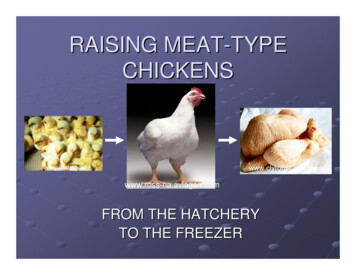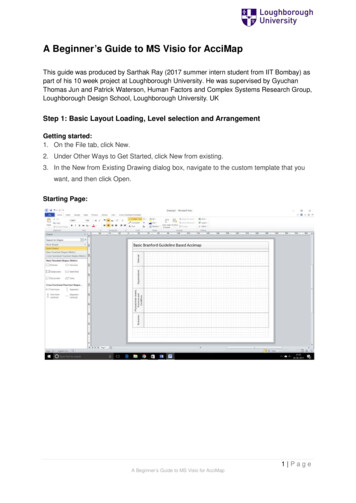
Transcription
CHICKENS 101:A BEGINNER’S GUIDETO RAISING BACKYARDCHICKENS
1What Do You Needto Raise Chickens?
1. HousingYour chicken needs a house to live, we call it a “coop”. A chickenrequires at least 3–4 square feet of space. So, if you’re planning toraise 4 chickens, you need to build/buy a 12-square foot chickencoop. If you need ideas for chicken coop, go to this he coop must have a good air circulation and lighting. So, makesure you have enough ventilation and place it where the naturalsunlight is sufficient.Inside the coop, you need to have two things:1. Nest boxes: for every 2 chickens you raise, you need 1 nest boxat the minimum size of 12’ x 12’ x 12’. This is where your henswill lay their eggs.2. Perches: Chickens don’t sleep on the floor; they sleep on aperch (also called roost).Note: get everything you need to raise chickens on this es/
2. Fenced areaAs I mentioned above, a chicken needs at least 3–4 square feet ofspace. But, this is not entirely true. In reality, they need 10 squarefeet of space if they spent most of the time indoor.If you’re not planning to do that, then you need to have an outdoorfenced area for your chicken where they’ll spend most of the time(other than sleeping). This outdoor area (or a “run”) should be atleast 3 square feet per chicken.3. WatererYou can’t use a bowl to water your chicken. They’ll flip it over. Use achicken waterer instead.You need to provide 1 quart of water per 4 chickens you raise. So ifyou only raise 2 chickens, then you need only 0.5 quarts.
4. FeedFor starters, it’s better to buy commercial pre-mix from local feedstore to feed your chicken instead of mixing your own. You can mixyour own feed later when you’re used to it.Avoid medicated feed, it does make your chickens bigger faster, butit’s for industrial chicken farming. If you want to raise your chickennaturally, you don’t need it.5. FeederThere are 2 types of feeder: grain feeder for grain feeds and feedpans for liquid feeds. They must be large enough to hold a day’sration, which is 1/4 - 1/3 pound per day per chicken.6. GritChickens don’t have teeth; they can’t chew their food. To help thembreak down and digest food easily, provide your chicken with grit.
7. Dust BathTo clean themselves from mites and bacteria, chickens don’t bath inwater. They do it in dust. Make sure to provide a dust bath, an openbox at the size of 2’ x 2’ x 16” filled with dust.8. CalciumEgg shells are made of calcium. If your chickens don’t get enough ofit, the shell will get broken easily (or the eggs will stuck inside!).The easiest way to provide calcium is by crushing their own eggshell and add it to their feeder. Also, add more calcium with oystershell from time to time. Make sure to have 1 pound of crushed shellsor per 100 pounds of feed.9. Brooder & IncubatorThis is necessary if you’re planning to hatch the chicks.
10. Bedding for nest boxesThe best materials for bedding are wood shavings, straw, or papershredding.Note: get everything you need to raise chickens on this es/
2How Much Do RaisingChicken Cost?
There are 2 types of cost in raising chickens: startup cost andmonthly cost. Startup cost is the money you spend once in thebeginning. Monthly cost, like its name, is the money you spendmonthly for recurring needs like food and supplies.Here’s the startup cost:1. Chicken coop: If you decide to DIY with recycled materials, achicken coop can be free. If you buy a prefabricated coop, thecost ranges from 200 to 2000.2. Fencing: An electric fencing costs around 170, and agalvanized wire mesh costs around 70 for the same size.3. Waterers and feeders: You can use bucket if you don’t want tospend money. The best waterer option in the market isavailable for around 40, and a feeder would cost you xxAnd here is the monthly cost (assuming you’re raising 3 hens):1. Feed: 152. Supplements etc.: 10
So, to get started in raising chickens, you’d spend around 350 to 2250 plus 25 per month per 3 chickens.But what about the profits or savings?Your chickens will produce eggs, compost, and manure. If youdecide to sell all of them, here’s your possible income for 3 hens:1.2.3.Eggs: 30–45 (60–90 eggs @ 0.05)Compost: 10Manure: 6If you have a garden and not selling them, you can count the profitas savings. This means, after the first month you’d get a profit of 5to 20 per chicken (excluding compost and manure).Note: get everything you need to raise chickens on this es/
3Daily, Weekly,Monthly, & SeasonallyChores
To give you an idea of what it takes to raise chickens, here’s the listof tasks you need to do on a daily, weekly, monthly, and seasonallybasis.Daily ChoresMorning: Feed chickensWash up and fill watererLet chickens out of their coopCheck the weatherCheck chicken’s healthLightly clean the coopAfternoon: Collect eggsAdd nest box shavings if necessaryGive treats to your chickens
Evening: Close up the chicken in the coopWeekly Chores Clean the coopReplace wood shavingsRefill supplements (oyster/egg shells, grit)Clean the runMove your chickens to a different spot (if mobile coop)Monthly Chores Stock up on supplies, take a trip to local stores (or purchasefrom Amazon)Seasonally Chores Inspect and repair the coopPrepare of changes in temperatureDeep clean your coop
4How Many ChickensShould I Get?
It depends on why you’re raising chickens in the first place.If you’re going to sell the eggs or meat, more chickens is better,obviously, because more chickens means more profit. But if you’reraising chickens to save money on food, then you have to make surethe hens produce optimum amount of eggs for the family.A heavy layer chicken will give you around 4–6 eggs per week. Withthis number, you can calculate how many chickens you need.Let’s say you’re a family of 4 who eat egg-based food every day.This means you’ll need to raise 4–5 hens.It’s better to start with fewer chickens and see if you can handlemore. If so, then you can get more chickens. This is better thangetting a lot of chickens at once and having to get rid of it later.Also, it’s important to know that a chicken will start laying at aroundfive months old and stop laying at 2.5 years old.
5Which Breed Should IGet?
Everyone has their favorites, and that can’t be denied when it comesto choosing chicken breeds. However, every breed is different whenwe’re talking egg productions.If you want your chickens to lay eggs (almost) every day, here arethe 5 breeds you might want to consider:1.2.3.4.5.White Leghorns: up to 280 eggs per yearRhode Island Red: up to 260 eggs per yearGolden Comet: 250–300 eggs per yearAmeraucana: up to 250 eggs per yearBarred Plymouth Rock: up to 280 eggs per yearOn the other hand, if you’re raising chickens for meat, these are thebest breeds:1.2.3.4.5.Cornish Cross: 8–12 lbsJersey Giant: 10–13 lbsBresse: 5–7 lbsOrpington: 8–10 lbsFreedom Rangers: 5–6 lbs
If you prefer both meat and eggs, then “dual-purpose” chickenbreeds are your friend. Rhode Island Red and Orpington are two ofthe most popular dual-purpose breeds.Read these articles to find out more popular breeds:1. Egg Breeds: http://morningchores.com/egg-laying-chickens/2. Meat Breeds: http://morningchores.com/meat-chickens/There you have it. Now you know everything you need to knowabout raising chickens.
So, to get started in raising chickens, you’d spend around 350 to 2250 plus 25 per month per 3 chickens. But what about the profits or savings? Your chickens will produce eggs, compost, and manure. If you decide to sell all of them, here’s your possible income for 3 hens: 1. Eggs: 30–45 (60–90 eggs @ 0.05) 2. Compost: 10











